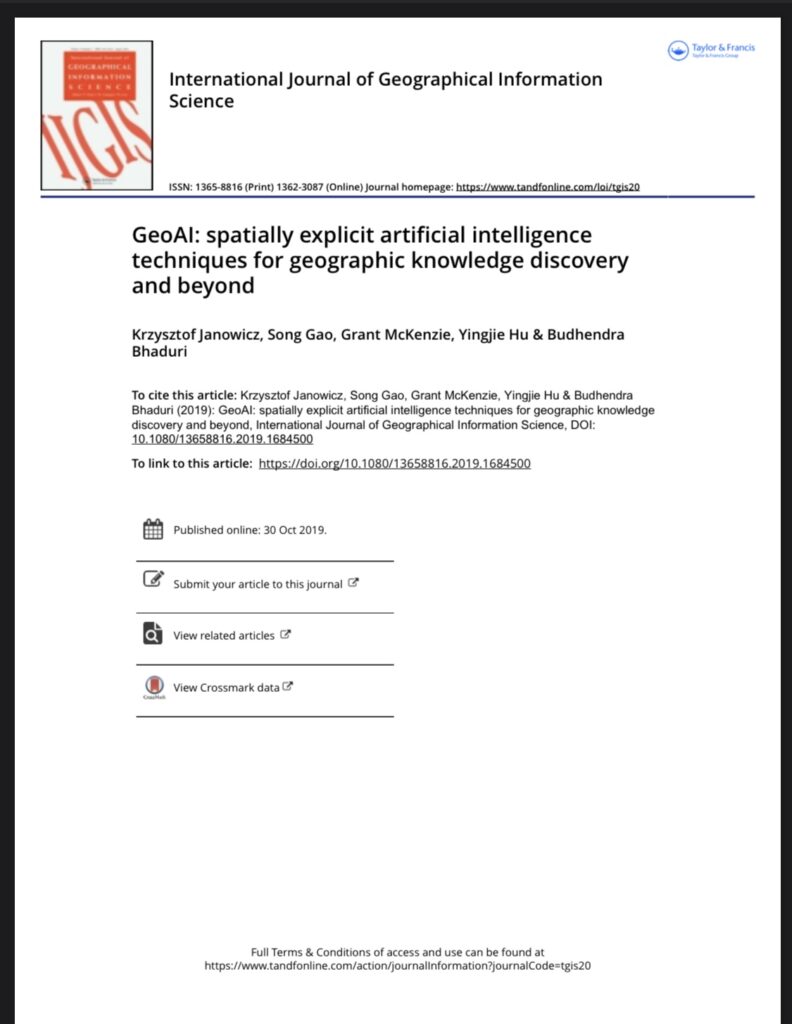
Abstract: What is the current state-of-the-art in integrating results from artificial intelligence research into geographic information science and the earth sciences more broadly? Does GeoAI research contribute to the broader field of AI, or does it merely apply existing results? What are the historical roots of GeoAI? Are there core topics and maybe even moonshots that jointly drive this emerging community forward? In this editorial, we answer these questions by providing an overview of past and present work, explain how a change in data culture is fueling the rapid growth of GeoAI work, and point to future research directions that may serve as common measures of success.
Moonshot (Editorial): Can we develop an artificial GIS analyst that passes a domain-specific Turing Test by 2030?
Keywords: Spatial Data Science, GeoAI, Machine Learning, Knowledge Graphs, Geo-Semantics, Data Infrastructure
Acknowledgement: we sincerely thank all the reviewers who contribute their time to the peer-review process and ensure the quality of the accepted papers.
Special Issue Papers (up to date):
Janowicz, K., Gao, S., McKenzie, G., Hu, Y., and Bhaduri, B. (2020, Editorial). GeoAI: Spatially Explicit Artificial Intelligence Techniques for Geographic Knowledge Discovery and Beyond. International Journal of Geographical Information Science, 34(4), 625-636.
Acheson, E., Volpi, M., & Purves, R. S. (2020). Machine learning for cross-gazetteer matching of natural features. International Journal of Geographical Information Science, 1-27.
Duan, W., Chiang, Y., Leyk, S., Uhl, J. and Knoblock, C. (2020). Automatic alignment of contemporary vector data and georeferenced historical maps using reinforcement learning. International Journal of Geographical Information Science, forthcoming. 1-27; DOI: 10.1080/13658816.2019.1698742.
Guo, Z., & Feng, C. C. (2020). Using multi-scale and hierarchical deep convolutional features for 3D semantic classification of TLS point clouds. International Journal of Geographical Information Science, 1-20.
Law, S., Seresinhe, C. I., Shen, Y., & Gutierrez-Roig, M. (2020). Street-Frontage-Net: urban image classification using deep convolutional neural networks. International Journal of Geographical Information Science, 1-27.
Li, W., & Hsu, C. Y. (2020). Automated terrain feature identification from remote sensing imagery: a deep learning approach. International Journal of Geographical Information Science, 1-24.
Ren, Y., Chen, H., Han, Y., Cheng, T., Zhang, Y., & Chen, G. (2020). A hybrid integrated deep learning model for the prediction of citywide spatio-temporal flow volumes. International Journal of Geographical Information Science, 1-22.
Sparks, K., Thakur, G., Pasarkar, A., & Urban, M. (2020). A global analysis of cities’ geosocial temporal signatures for points of interest hours of operation. International Journal of Geographical Information Science, 1-18.
Xie, Y., Cai, J., Bhojwani, R., Shekhar, S., & Knight, J. (2020). A locally-constrained YOLO framework for detecting small and densely-distributed building footprints. International Journal of Geographical Information Science, 1-25.
Zhu, D., Cheng, X., Zhang, F., Yao, X., Gao, Y., & Liu, Y. (2020). Spatial interpolation using conditional generative adversarial neural networks. International Journal of Geographical Information Science, 1-24.